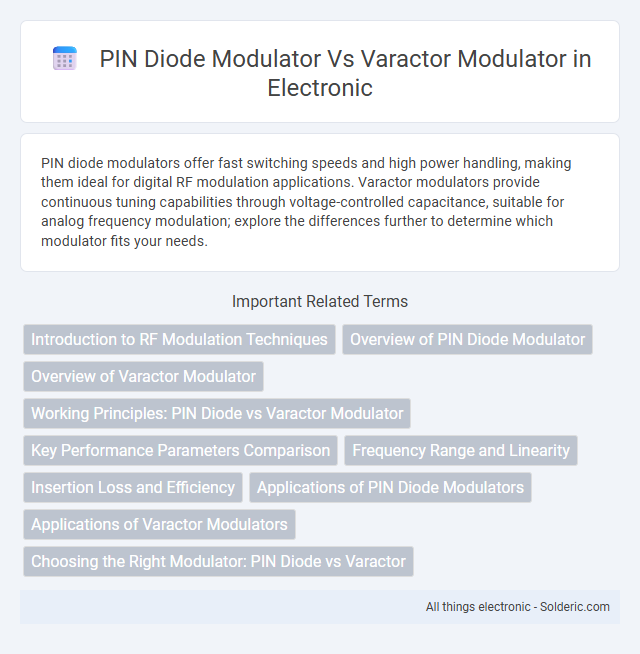PIN diode modulators offer fast switching speeds and high power handling, making them ideal for digital RF modulation applications. Varactor modulators provide continuous tuning capabilities through voltage-controlled capacitance, suitable for analog frequency modulation; explore the differences further to determine which modulator fits your needs.
Comparison Table
| Feature | PIN Diode Modulator | Varactor Modulator |
|---|---|---|
| Operating Principle | Uses PIN diode's variable resistance under forward bias | Uses varactor diode's capacitance variation with reverse bias |
| Modulation Type | Amplitude and phase modulation | Phase and frequency modulation |
| Frequency Range | Up to several GHz | Up to tens of GHz |
| Insertion Loss | Higher insertion loss due to diode resistance | Lower insertion loss with capacitive tuning |
| Power Handling | High power handling capability | Lower power handling capability |
| Linearity | Good linearity for amplitude modulation | Non-linear capacitance vs voltage relationship |
| Application | Switches, attenuators, RF modulators | Tunable filters, phase shifters, voltage-controlled oscillators |
| Control Voltage | Forward bias current | Reverse bias voltage |
| Speed | Moderate switching speed | High-speed tuning |
Introduction to RF Modulation Techniques
PIN diode modulators use a semiconductor diode with an intrinsic layer to control RF signal amplitude or phase by varying resistance, offering fast switching speeds and high linearity ideal for pulsed RF applications. Varactor modulators rely on voltage-controlled capacitance changes in varactor diodes to achieve frequency or phase modulation with low power consumption but generally slower response times than PIN diode systems. Your choice between PIN diode and varactor modulators depends on specific RF modulation requirements such as speed, linearity, and power efficiency.
Overview of PIN Diode Modulator
PIN diode modulators leverage the intrinsic layer of the diode to control RF signals through rapid switching and attenuation, providing high linearity and wide bandwidth in microwave applications. These modulators excel in high-power environments due to their ability to handle significant power levels without distortion, making them ideal for radar and communication systems. The fast switching speed and low insertion loss of PIN diode modulators enable efficient amplitude and phase modulation compared to varactor modulators, which primarily rely on capacitance variation.
Overview of Varactor Modulator
Varactor modulators utilize voltage-controlled capacitance changes in varactor diodes to achieve high-frequency signal modulation with low distortion and minimal power consumption. They are ideal for applications requiring precise phase or frequency modulation due to their fast response and compact design. You benefit from varactor modulators' efficient tuning capabilities in RF circuits, especially in communication systems and signal processing devices.
Working Principles: PIN Diode vs Varactor Modulator
PIN diode modulators operate by varying the resistance of the intrinsic layer under forward bias, enabling rapid switching for amplitude modulation in RF circuits. Varactor modulators utilize voltage-controlled capacitance changes in the varactor diode to achieve phase or frequency modulation with high precision. Your choice between these modulators depends on whether amplitude or frequency modulation aligns better with your application's requirements.
Key Performance Parameters Comparison
PIN diode modulators offer high linearity and fast switching speeds, making them ideal for applications requiring precise amplitude modulation and low signal distortion. Varactor modulators excel in frequency tuning range and low insertion loss, providing efficient phase modulation with minimal power consumption. Your choice depends on whether high-speed modulation or wide tuning range is the primary performance requirement.
Frequency Range and Linearity
PIN diode modulators operate effectively across a broad frequency range, typically from HF to microwave bands, offering high linearity suitable for precision RF applications. Varactor modulators excel at higher frequencies, particularly in the VHF to microwave spectrum, but exhibit lower linearity due to their capacitance-voltage nonlinear characteristics. Frequency range and linearity considerations guide the choice between PIN diode modulators for wideband, high-linearity needs and varactor modulators for high-frequency tuning with acceptable linearity trade-offs.
Insertion Loss and Efficiency
PIN diode modulators typically exhibit lower insertion loss due to their intrinsic layer that reduces signal attenuation, enhancing overall efficiency in high-frequency applications. Varactor modulators, while offering voltage-controlled capacitance tuning, often suffer from higher insertion loss because of the nonlinear junction capacitance and resistive components. Your choice depends on balancing the trade-off between modulator efficiency and the acceptable insertion loss for your specific RF or microwave system design.
Applications of PIN Diode Modulators
PIN diode modulators are widely used in high-frequency applications such as RF switching, amplitude modulation, and phase shift keying due to their fast switching speed and high linearity. They are essential in microwave communication systems, radar transmitters, and signal processing where precise modulation control is required. Your system benefits from PIN diode modulators when reliable performance and low insertion loss are critical for dynamic signal modulation.
Applications of Varactor Modulators
Varactor modulators are widely used in frequency modulation (FM) and phase-locked loop (PLL) circuits due to their precise voltage-controlled capacitance, enabling fine-tuned frequency adjustments. They excel in applications such as voltage-controlled oscillators (VCOs), RF phase shifters, and tunable filters, where linearity and low distortion are critical. Varactor modulators offer high-frequency operation and low power consumption, making them ideal for compact, high-performance communication systems and radar technologies.
Choosing the Right Modulator: PIN Diode vs Varactor
PIN diode modulators excel in high-power applications due to their ability to handle large RF signals with fast switching speeds and low distortion, making them ideal for pulse and amplitude modulation in radar and communication systems. Varactor modulators offer precise, linear capacitance tuning suited for frequency modulation and voltage-controlled oscillators in low-power, high-frequency environments, providing fine frequency control with minimal signal loss. Selecting the right modulator hinges on application requirements: prioritize PIN diodes for power handling and switching speed, while varactors enable frequency agility and compact circuit design.
PIN diode modulator vs varactor modulator Infographic

 solderic.com
solderic.com